 Apple Computer shares dropped Tuesday as Sony relaunched its famous Walkman line amongst concerns that increased competition from Napster might impact its dominance of online music and portable players.
Apple Computer shares dropped Tuesday as Sony relaunched its famous Walkman line amongst concerns that increased competition from Napster might impact its dominance of online music and portable players.
The soaraway success of the iPod music player has transformed Apple’s balance sheet and its stock price, with the company shining as one of the best performers in the Nasdaq technology index over the past year.
But some industry pundits are predicting that Apple is being damaged by serious competition from a new generation of smaller, sleeker and cheaper MP3 players from the likes of Sony, Rio and Creative and a host of online music services led by Napster.
Shares of Apple have dropped 8.5 percent since the announcement of the stock split on 11 February, and have fallen some 6 percent this week alone.
“Competition concerns are certainly going to influence how this stock trades,” said Warren West, principal at Philadelphia-based GreenTree Brokerage Services, which executes trades for institutional investors such as asset managers and hedge funds. “Investors in general have enjoyed the stock moves, there’s a lot of money that has been made, and people are going to start taking profits _ especially after the split.”
 Over the last twelve months, Apple’s share price has gone from US$23 (€17/£12) to an all-time high of US$81.99 (€61/£42) just before the split was announced.
Over the last twelve months, Apple’s share price has gone from US$23 (€17/£12) to an all-time high of US$81.99 (€61/£42) just before the split was announced.
Investors must now decide if the company’s share price can maintain its strength in the face of a market getting becoming increasingly crowded with rival products.
Sony are aggressively targeting the iPod with their Walkman line of digital music players, hoping to woo customers with lightweight and compact flash memory players instead of bulkier, hard drive-based units.
In fact, many of the new iPod alternatives aren’t trying to compete with Apple’s player at the high end but are focussing on consumers who are choosing between cheaper, lower-storage-capacity flash-media players and pricier, entry-level hard-drive players that hold more than 1,000 songs.
The Sony flash-media players will be knocked out for as low as US$130 (€97/£68) – not as cheap as the new iPod Shuffle, but considered to be better value because of a longer battery life and more features.
“Flash is going to be here for a while, because it’s more affordable,” Kelly Davis, product manager for Sony Electronics, says. “People are trying to get more capacity for their dollar.
The new Sony players are expected to give the company the No. 2 position in the portable music player market by next year.
Apple’s iTunes service is also coming under attack, with rival Napster recently boosting its sales outlook with growing demand for its new “Napster To Go” subscription service, expected to generate US$15 million for its fiscal fourth quarter.
Apple is also experiencing competition from music services offered by rivals such as Microsoft Corp., Real Networks, and Yahoo.
The company still remains in good shape though, with Piper Jaffray analyst Gene Munster predicting continuing good sales for the iPod line.
“Our checks have left us more confident that demand for Apple’s key products most notably iMac, Powerbook, Mac mini and various versions of the iPod continue to be ahead of expectations,” Munster told clients in a research report. “We anticipate that strong demand across various segments of the company will allow Apple to exceed Wall Street estimates for overall revenue and earnings.”
Munster expects the company to report earnings of US$1.04 (€0.77 /£0.53) per share on revenue of US$12.81 billion in 2005, up from previous expectations of a 98% share profit on sales of US$12.25 billion.
Piper Jaffray told clients it expects Apple to sell 3.8 million iPods during the second quarter, including 1 million iPod shuffle models, followed by 4.6 million iPods during the third quarter, with the Shuffle model accounting for 1.8 million of the sales.
Apple Shares Fall on Sony, Napster Fears (PA)
Sony MP3 players
Apple iPod
 Amazon.com’s revenue soared internationally in the second quarter as electronics and other non-book bits’n’bobs made up more of its business.
Amazon.com’s revenue soared internationally in the second quarter as electronics and other non-book bits’n’bobs made up more of its business. Amazon.com’s chief financial officer, Tom Szkutak, announced that third-party sales accounted for 28 percent of Amazon.com’s total items sold, sprightly stepping up from 24 percent for this time last year.
Amazon.com’s chief financial officer, Tom Szkutak, announced that third-party sales accounted for 28 percent of Amazon.com’s total items sold, sprightly stepping up from 24 percent for this time last year. This includes US$56 million (~£32.25m, ~€46.6m) in income tax expense, which was up from US$5 million (~£2.87m, ~€4.16m) a year earlier.
This includes US$56 million (~£32.25m, ~€46.6m) in income tax expense, which was up from US$5 million (~£2.87m, ~€4.16m) a year earlier. Champagne corks were firing off at Google like a military salute as the Internet search engine kings revealed that their profits had jumped more than 300 per cent in the second quarter this year.
Champagne corks were firing off at Google like a military salute as the Internet search engine kings revealed that their profits had jumped more than 300 per cent in the second quarter this year. The company’s fortunes are currently on a stratospheric trajectory, with April’s first-quarter profit almost six times higher than a year earlier.
The company’s fortunes are currently on a stratospheric trajectory, with April’s first-quarter profit almost six times higher than a year earlier. Vodafone execs spent the morning cackling wildly to themselves, throwing wads of dollar bills in the air and rolling around silk-covered beds covered in cash as record revenues and profits for its full year results were announced to the world.
Vodafone execs spent the morning cackling wildly to themselves, throwing wads of dollar bills in the air and rolling around silk-covered beds covered in cash as record revenues and profits for its full year results were announced to the world. But in-between triumphant licks of triple-thick Cornish clotted cream, Sarin sounded a cautious note, warning that competition was rising.
But in-between triumphant licks of triple-thick Cornish clotted cream, Sarin sounded a cautious note, warning that competition was rising.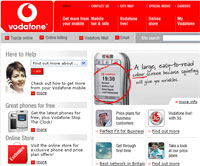 Vodafone performed particularly well in strong markets such as the US and Spain, with revenues growing at more than 20% year on year.
Vodafone performed particularly well in strong markets such as the US and Spain, with revenues growing at more than 20% year on year.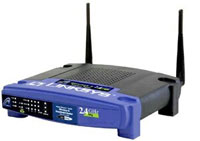 Despite prices being pushed downwards by fierce price competition, worldwide wireless LAN equipment revenue rose 20% to US$767.6 million (~£420m ~€610m) between the fourth quarter of 2004 and the first quarter of 2005.
Despite prices being pushed downwards by fierce price competition, worldwide wireless LAN equipment revenue rose 20% to US$767.6 million (~£420m ~€610m) between the fourth quarter of 2004 and the first quarter of 2005.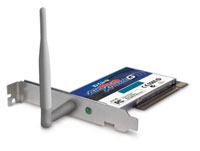 That’s a thumping great 37% increase in unit shipments, representing not-to-be-scoffed-at sales of 6 million.
That’s a thumping great 37% increase in unit shipments, representing not-to-be-scoffed-at sales of 6 million.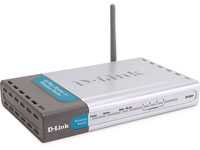 D-Link barged ahead of Cisco-Linksys to grab second place, with NETGEAR in fourth position.
D-Link barged ahead of Cisco-Linksys to grab second place, with NETGEAR in fourth position. Ericsson has reported a thumping great rise in quarterly profits, helped by the deployment of 3G networks.
Ericsson has reported a thumping great rise in quarterly profits, helped by the deployment of 3G networks. These figures fly in the face of predictions from investors and analysts that sales would drop steadily for the big telecoms firms as Chinese manufacturers took over the industry.
These figures fly in the face of predictions from investors and analysts that sales would drop steadily for the big telecoms firms as Chinese manufacturers took over the industry. Champagne corks were popping like manic machine gun fire at Google yesterday as the company reported a thumping fivefold increase in profits in the first quarter.
Champagne corks were popping like manic machine gun fire at Google yesterday as the company reported a thumping fivefold increase in profits in the first quarter. Revenues generated from Google’s partner sites through its AdSense programs generated $584 million, or 47 percent of revenues, – a hefty 75 percent increase over partner-related revenues a year ago.
Revenues generated from Google’s partner sites through its AdSense programs generated $584 million, or 47 percent of revenues, – a hefty 75 percent increase over partner-related revenues a year ago. Online retail giant Amazon.com has scooped up the ‘printing fulfillment’ company BookSurge, which maintains a catalogue of thousands of book titles available for users to print on demand.
Online retail giant Amazon.com has scooped up the ‘printing fulfillment’ company BookSurge, which maintains a catalogue of thousands of book titles available for users to print on demand. The company will now offer (cue: North American accent) “inventory-free book fulfillment” to publishers through BookSurge Publisher Services and to authors through BookSurge Publishing.
The company will now offer (cue: North American accent) “inventory-free book fulfillment” to publishers through BookSurge Publisher Services and to authors through BookSurge Publishing. Apple Computer shares dropped Tuesday as Sony relaunched its famous Walkman line amongst concerns that increased competition from Napster might impact its dominance of online music and portable players.
Apple Computer shares dropped Tuesday as Sony relaunched its famous Walkman line amongst concerns that increased competition from Napster might impact its dominance of online music and portable players. Over the last twelve months, Apple’s share price has gone from US$23 (€17/£12) to an all-time high of US$81.99 (€61/£42) just before the split was announced.
Over the last twelve months, Apple’s share price has gone from US$23 (€17/£12) to an all-time high of US$81.99 (€61/£42) just before the split was announced. Frontier Silicon, the British company that makes chips for mobile digital television and digital radio products, has completed it US$28 million (€21m/£14.5m) investment round funding.
Frontier Silicon, the British company that makes chips for mobile digital television and digital radio products, has completed it US$28 million (€21m/£14.5m) investment round funding. “This latest investment allows us to aggressively target and drive market share in the emerging mobile digital television market in the same way that we have established our chips in over 70 percent of DAB digital radios,” said Anthony Sethill.
“This latest investment allows us to aggressively target and drive market share in the emerging mobile digital television market in the same way that we have established our chips in over 70 percent of DAB digital radios,” said Anthony Sethill.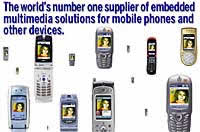 In their 2005 “State of the Company” address just made public,
In their 2005 “State of the Company” address just made public,  PacketVideo specialises in building and ‘commercializing’ (we think that’s American for “selling”) multimedia capabilities such as VOD, music on demand (MOD) and two-way video communication and messaging.
PacketVideo specialises in building and ‘commercializing’ (we think that’s American for “selling”) multimedia capabilities such as VOD, music on demand (MOD) and two-way video communication and messaging.